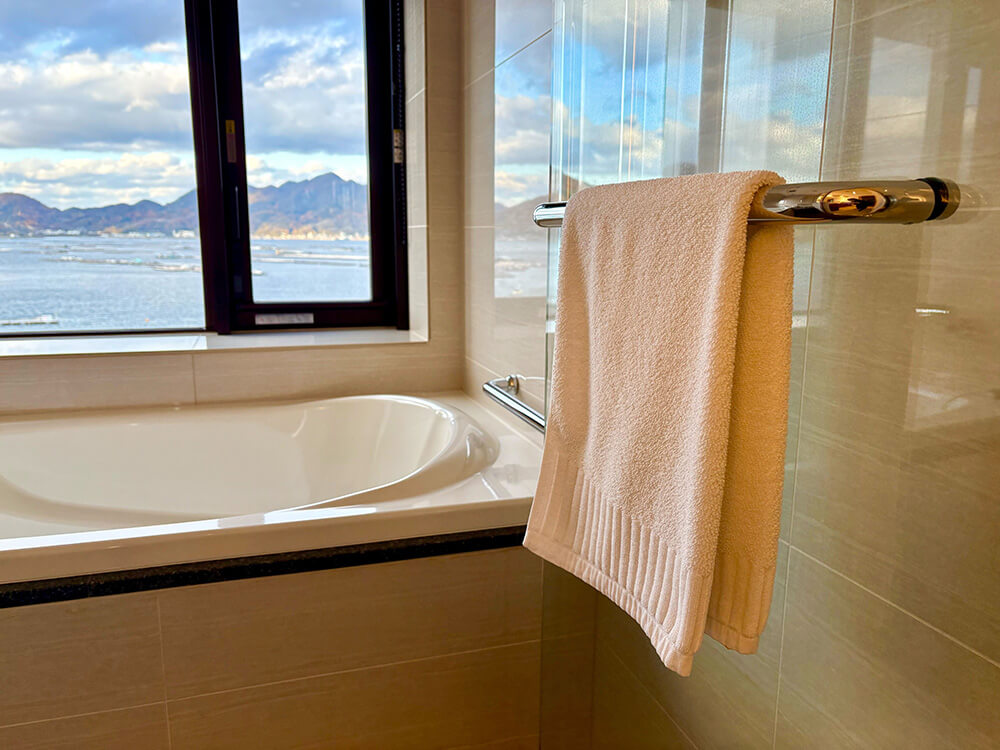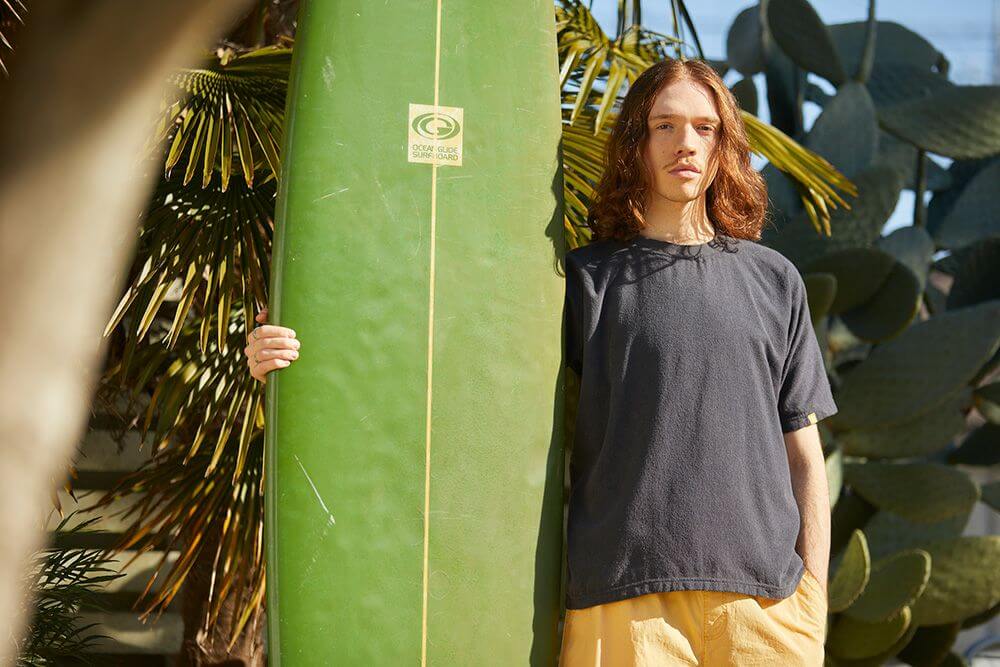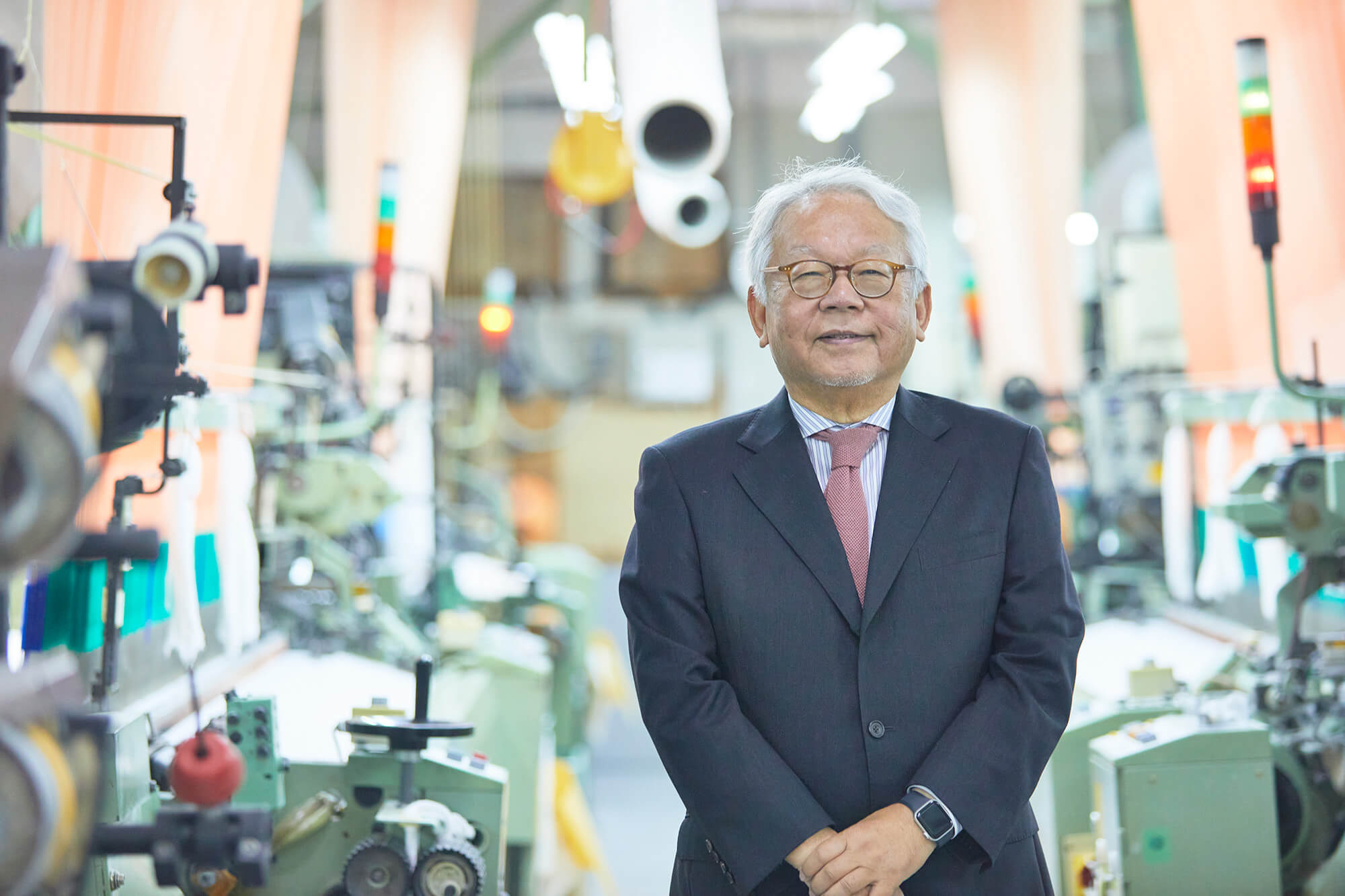タオルのお役立ちコラムやイケウチオーガニックの取り組みをご紹介いたします。
Which towels are easy to dry indoors during the rainy season?
2018.02.01
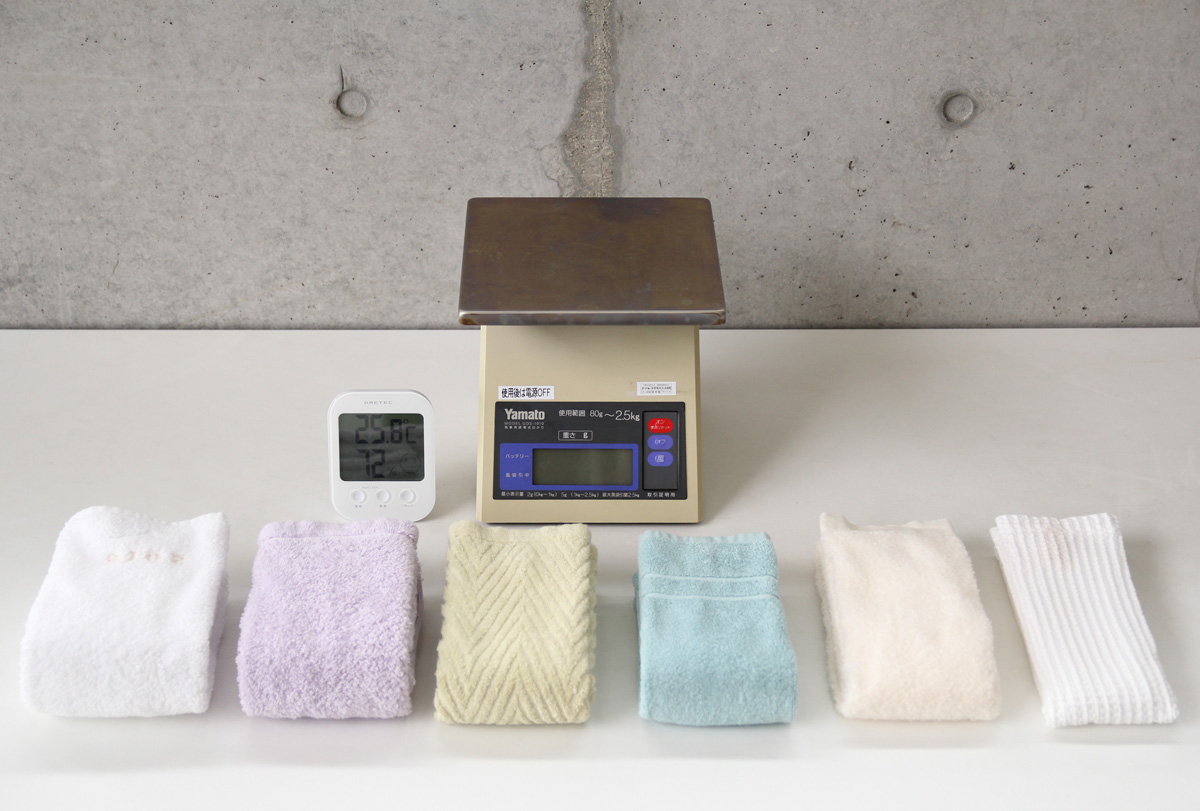
Table of Contents
From June to July, we are in the rainy season. This year, after the rainy season was declared nationwide, there was little rainfall, but the weather became rainy season-like with high humidity and rain. During the rainy season, it is difficult to dry laundry, and many households suffer from the smell of freshly dried laundry or have to use the dryer or air conditioner to take care of it.
In this issue of Towel Clinic, we asked the question, “Which towels are easy to dry when drying indoors during the rainy season? We washed and room-dried six representative IKEUCHI ORGANIC face towels to find out which one dries the fastest. Which towel dries the fastest and is it effective for room-drying during the rainy season? We would like to verify which towel dries the fastest and which dries the least.
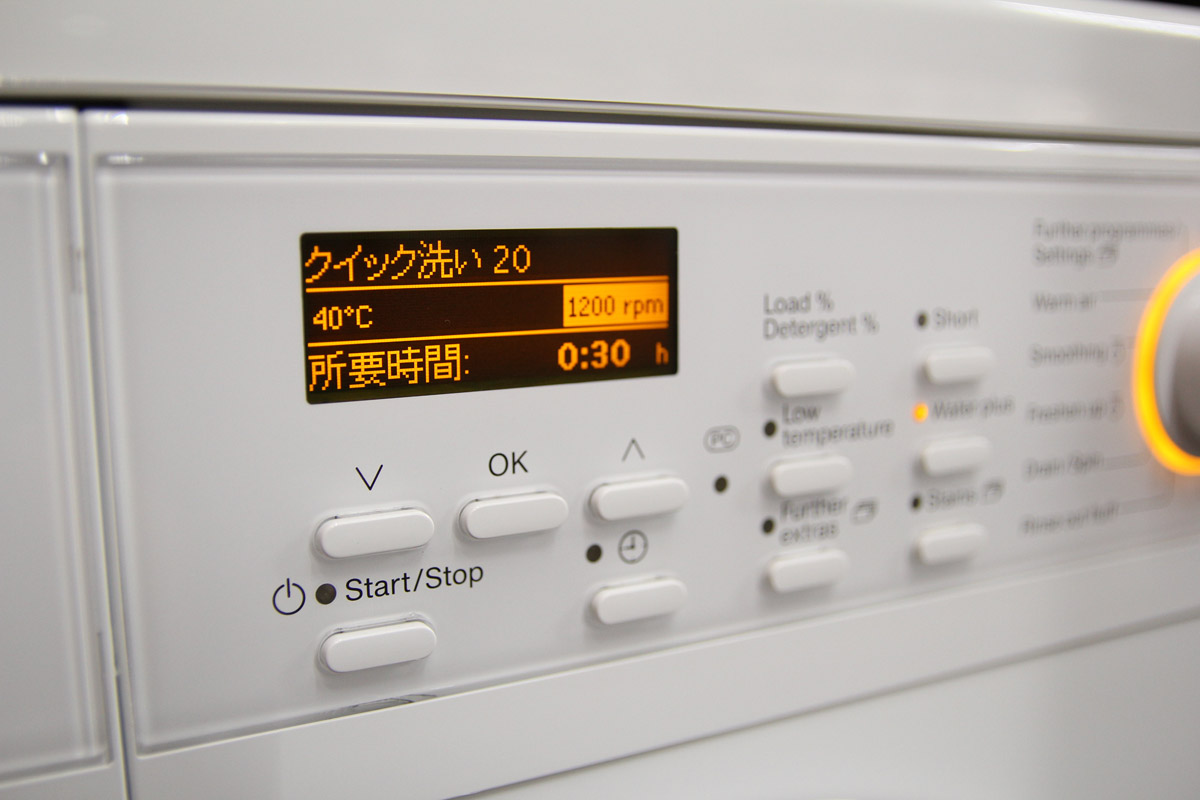
Experimental Method
The experimental regulations for this experiment are as follows.
The washing machine used for washing clothes was a washing machine made by Miele, a German home appliance manufacturer. The machine was set to Express 20 course, water temperature 40 degrees Celsius, 1200 rpm, Water Plus, and Matsuyama Oil Powder Soap.
The laundry was washed and dried indoors on a foldable clothes dryer.
Weigh the towels before washing and measure every 10 minutes after drying.
Six types of IKEUCHI ORGANIC face towels appeared
The towels appearing in this experiment are introduced below, along with photos of the towels weighed before washing.
Course 1: Organic 120
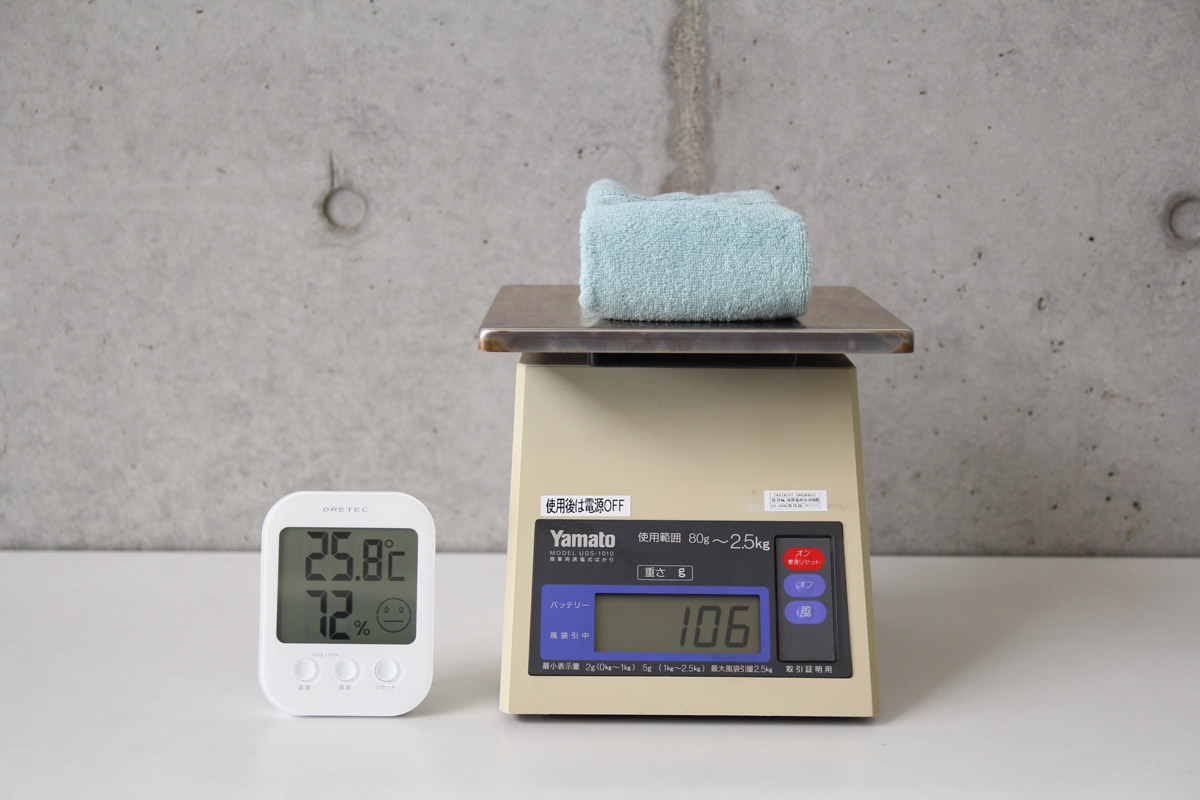
A permanent standard of IKEUCHI ORGANIC. The material is 100% organic cotton, with a slightly thicker yarn (20 count), but as IKEUCHI’s benchmark towel, we can expect it to dry quickly as well.
Course 2: Organic 520
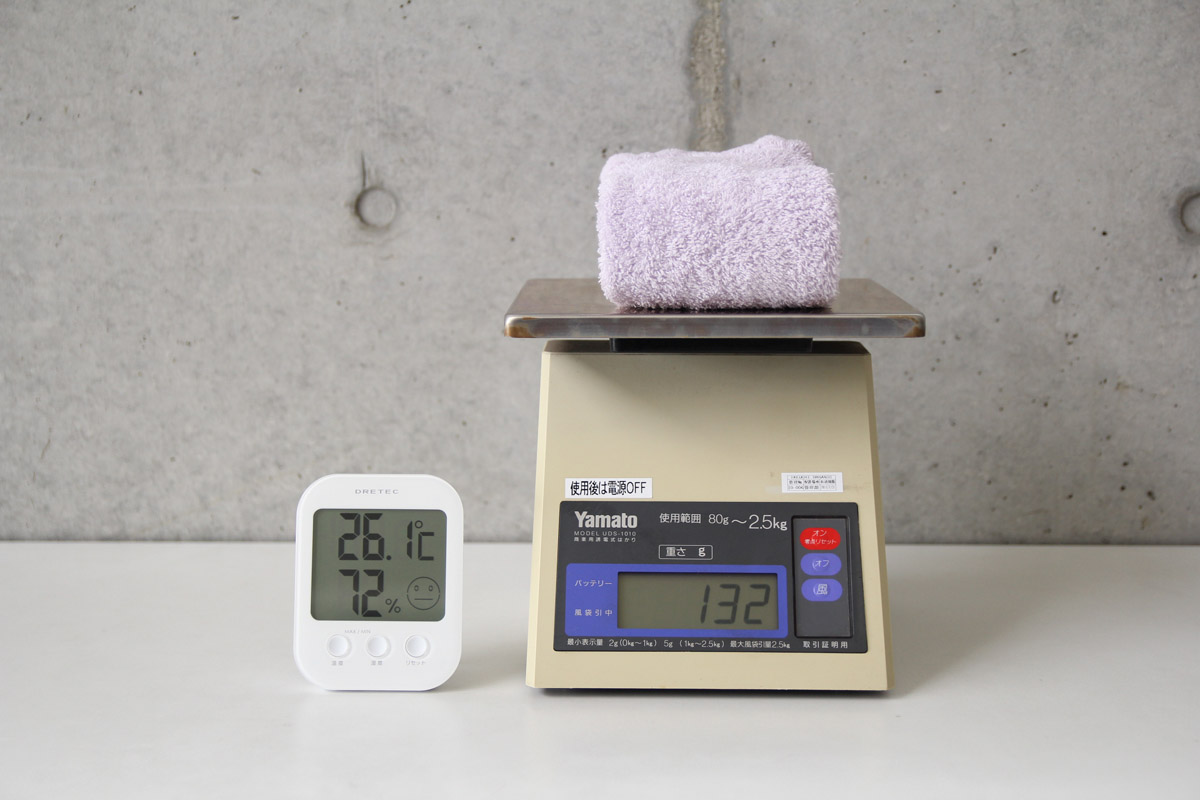
This towel is designed for softness. It is made with the same 20 count yarn as Organic 120, but the pile length is longer than that of Organic 120, which may be a disadvantage for quick-drying.
Course 3: Organic Air
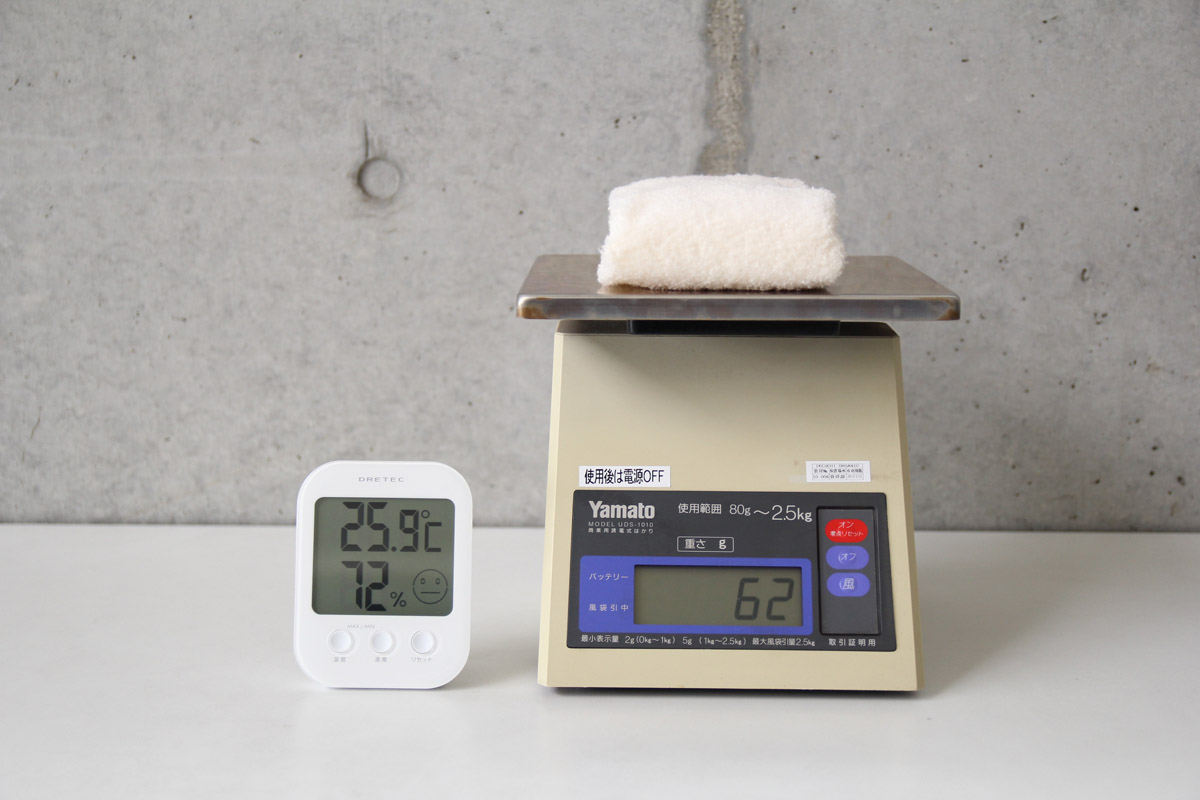
One of the main choices for this year’s “Rainy Season Room Drying Cup” (self-named). 60-count yarn and a pile density that seems to allow air to pass through it well. Can we prove the causal relationship between lightness and quick-drying performance?
Course 4: Cotton Nouveau 2016
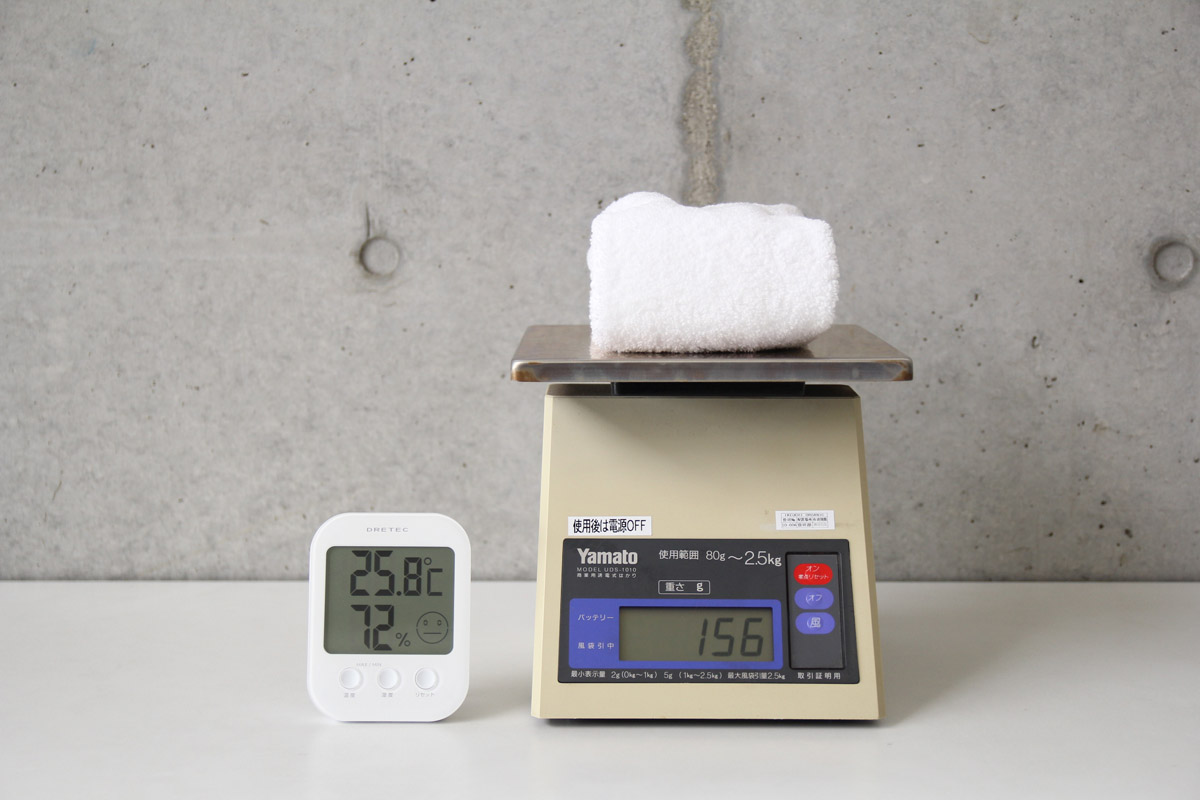
The heaviest of the towels appearing in this year’s exhibition. Will the use of luxurious yarns and the characteristics of organic cotton from Tanzania and a single species prove to be a good thing or a bad thing?
Course 5: Bamboo 120
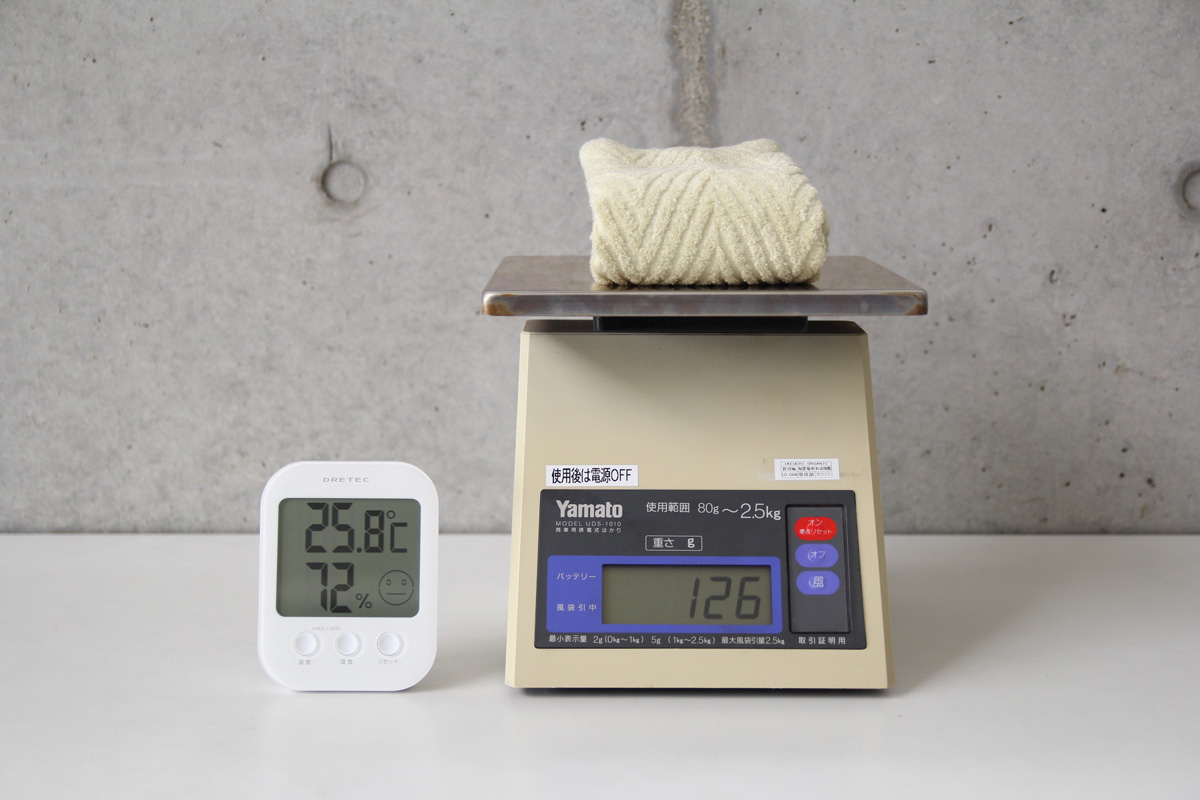
Bamboo 120 uses more bamboo rayon, which is more absorbent than organic cotton, with a yarn count of 20 and the same pile length as that of Organic 120. It will be interesting to see how much the difference in materials will affect the quality of the fabric.
Course 6: Organic I 340
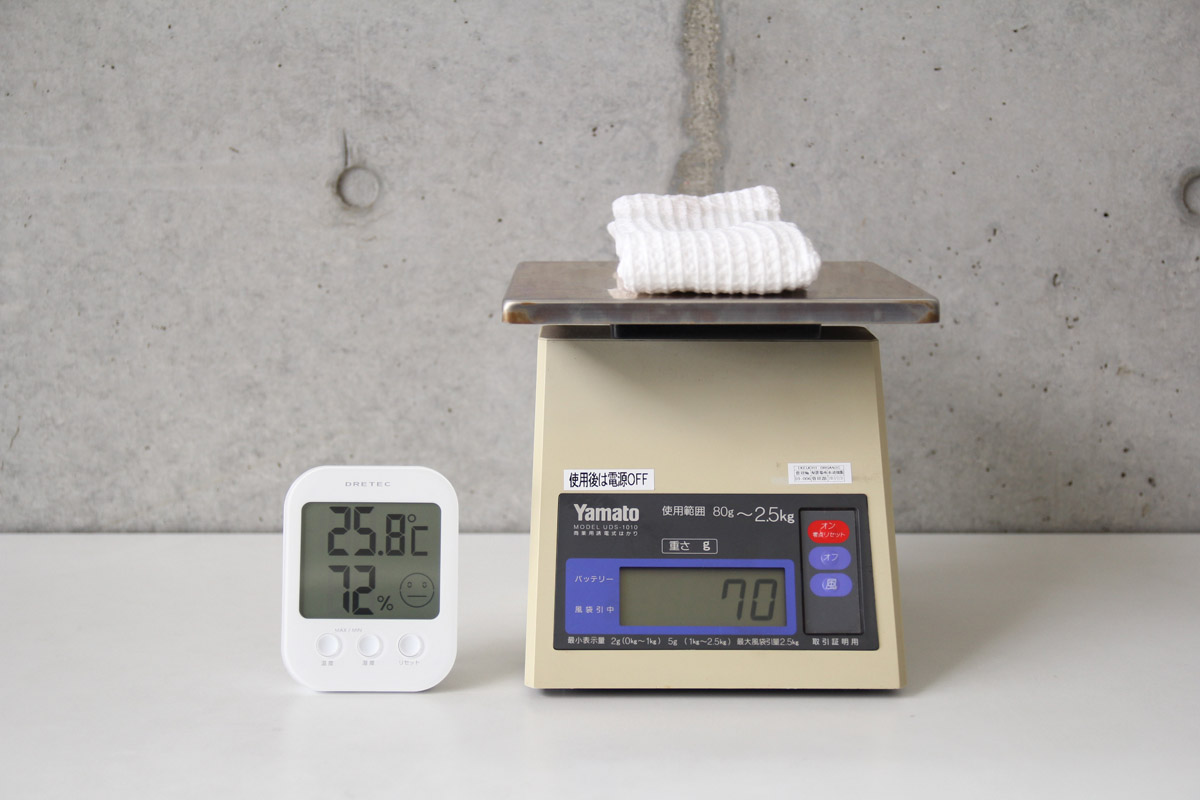
This is the only towel without pile. The unevenness of the waffle fabric increases the area in contact with the air, which is advantageous for drying. It is the second heaviest towel in terms of overall weight, following Organic Air, making it a dark horse in this year’s competition.
Quick-drying towel predictions by experts
After introducing the contestants, we asked our knowledgeable staff, Towel Doctor Abe, who is the company president and the most knowledgeable towel washing expert, Towel Designer Yano, who is in charge of towel design, and Kyoto Store Staff Yoshikawa, who touches and washes towels every day when serving customers, to predict the results of this experiment.

Towel Doctor Abe’s prediction
No. 1 Organic I340
No. 2 Organic Air
No. 3 Organic 120
4th Organic 520
No. 5 Cotton Nouveau 2016
No. 6 Bamboo 120
Prediction comments: No. 1, “Organic I340,” because it has no pile and is light. Next is “Air” with the lightest and finest count yarn, followed by “Organic 120” with high density but short pile and flat hem. Next was “Organic 520,” which is the lightest and finest yarn, followed by “Organic 520. Cotton Nouveau,” which is predicted to finish fifth, has a more dense structure than 520 but a flat hem, so the total drying time will be about the same as 520. The lowest ranked is “Bamboo 120,” which is the slowest because it is made of bamboo and has a pile hem.

Designer Yano’s Prediction
No. 1 Organic Air
No. 2 Organic I340
No. 3 Bamboo 120
No. 4 Organic 120
No. 5 Organic 520
6th Cotton Nouveau 2016
Prediction comments: As a design engineer, I could look at the design specifications and calculate the weight based on yarn count and square meter weight, but I feel that would be cheating, so I’ll just go with my gut feeling. The favorite is still “Organic Air,” which sells lightness and quick-drying. The close runner-up is “I340″ for its advantage of having no pile. Nouveau” is expected to lag behind others in terms of quick-drying due to its heavy weight.
The two pieces of interest in this race are “Organic 120” and “Bamboo 120”. The design elements of these two pieces are almost equal except for the difference in materials, organic cotton and bamboo rayon, so we are looking forward to seeing how the difference in materials will be reflected in the results.

Kyoto Store Yoshikawa’s Prediction
No. 1 Organic Air
No. 2 Organic 120
No. 3 Organic I340
4th Organic 520
No.5 Cotton Nouveau 2016
6th Bamboo 120
Predictive comments: I came up with the ranking based on my own experience of washing and using the towels that I try on customers every day.
The fastest by far is “Organic Air”. Organic 120″ and “Organic I340” are not so different. 4th place “Organic 520” dries faster than “Organic Air” because of its long pile. 5th and 6th place are “Cotton Nouveau 2016” and “Organic I340” with density. I was torn between “Cotton Nouveau 2016” and “Bamboo 120”. I thought “Cotton Nouveau” would have a higher pile and a larger surface area, so it would dissipate moisture more quickly. Bamboo absorbs water at once. Bamboo absorbs and stores water at once, but I feel that it releases moisture more slowly than cotton-only towels, so I chose it as No. 6.
Organic Air is the main contender for quick-drying towels, while Organic I340 is its opponent.
The three experts predicted that “Organic Air” and “Organic I340” would be at the top of the list, while “Bamboo 120” and “Cotton Nouveau 2016” would be at the bottom. What will the results be? Let the laundry drying experiment begin!
The weather outside is rainy, and the experiment will be held under very rainy season-like conditions.
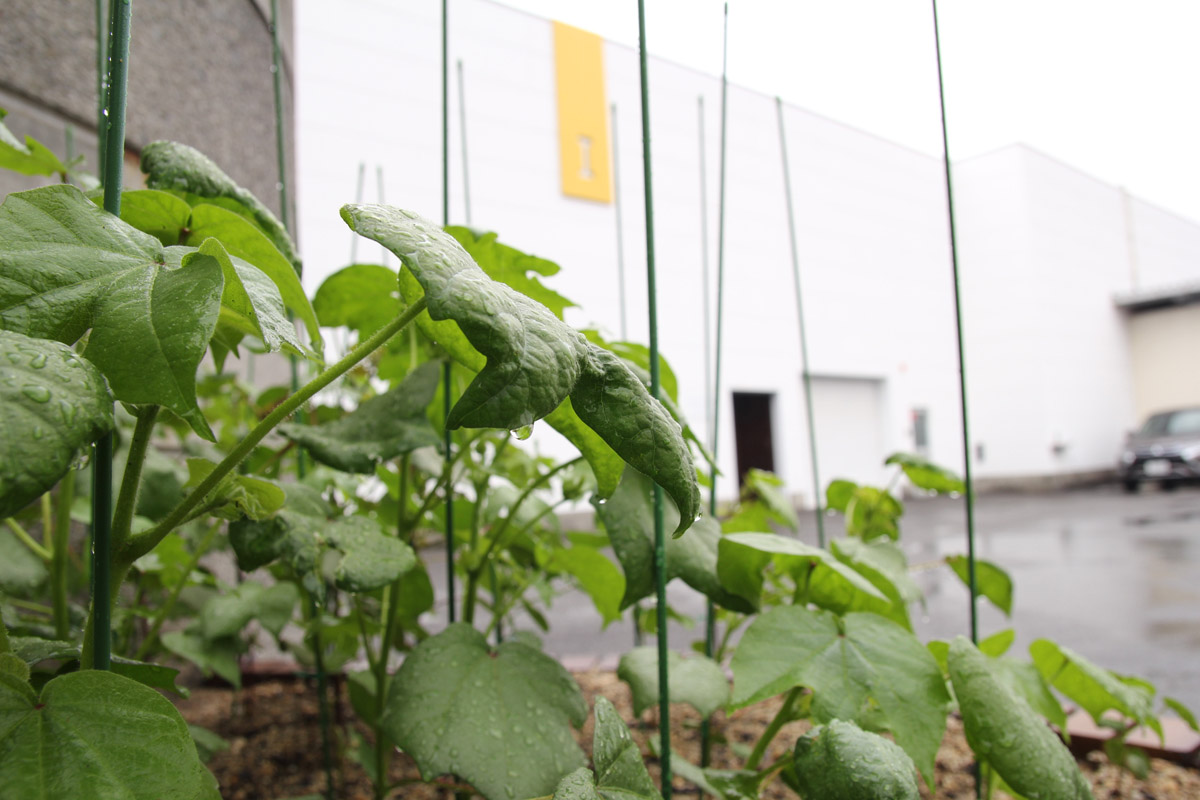
Measurements before washing Room temperature: 26.1 degrees Celsius, humidity: 72%.
| Organic Air | 62g |
| Organic I340 | 70g |
| Organic 120 | 106g |
| Bamboo 120 | 126g |
| Organic 520 | 132g |
| Cotton Nouveau 2016 | 156g |
In the pre-wash weigh-in, “Organic Air” weighed 62g and “Organic I340” 70g, about half the weight of the heaviest “Cotton Nouveau”. Will they take advantage of their overwhelming lightness to finish as they are rated? With high expectations, we put all the towels into the washing machine.
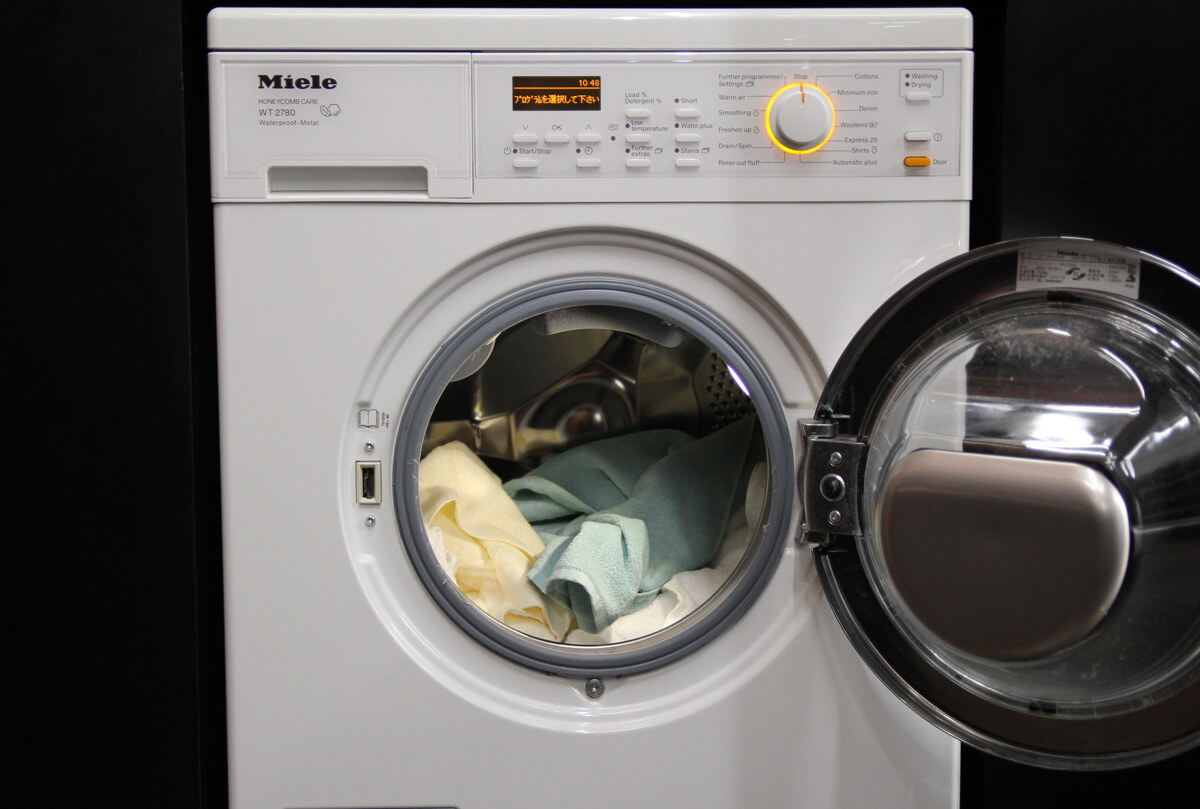
During washing
Washing is performed in the Water Plus mode, in which the towels are beaten against the drum with more water. Please watch the movie for a while…
Finished washing and weighing before drying
After the laundry is successfully finished, the machine weighs how much water is in the machine. But there was a problem here! The room where the towels are to be dried is being used for a conference, and the air conditioner is running. The conditions were such that both the temperature and humidity would drop. However, we continued the experiment as it was, because air conditioning may be turned on when drying towels in a living space.
Weighing after washing Room temperature 23.7°C, humidity 59%.
Cotton Nouveau 2016 238g 82g
| Organic Air | 94g | 32g |
| Organic I340 | 114g | 44g |
| Organic 520 | 190g | 58g |
| Organic 120 | 170g | 64g |
| Bamboo 120 | 220g | 94g |
Of special note is “Bamboo 120”. It absorbs a large amount of moisture by containing more bamboo rayon. Simply put, the increased weight after washing is moisture, so one might expect that the order of decreasing moisture content would reach the goal. How did the results turn out?
Start of room drying
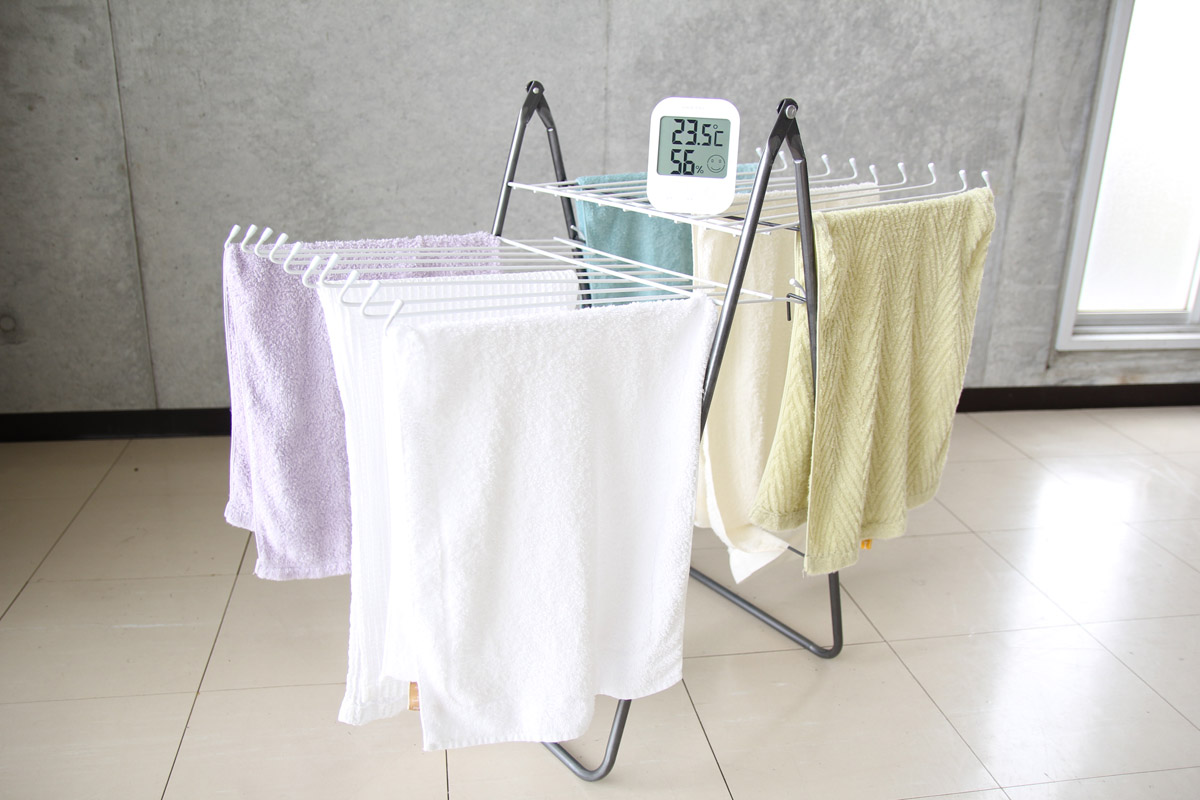
The room temperature is 23.5 degrees Celsius and the humidity is 56%. From now on, we will observe every 10 minutes, and when we judge that it is getting dry by touch, we will weigh it and judge its dryness.
~120 minutes (2 hours) elapsed
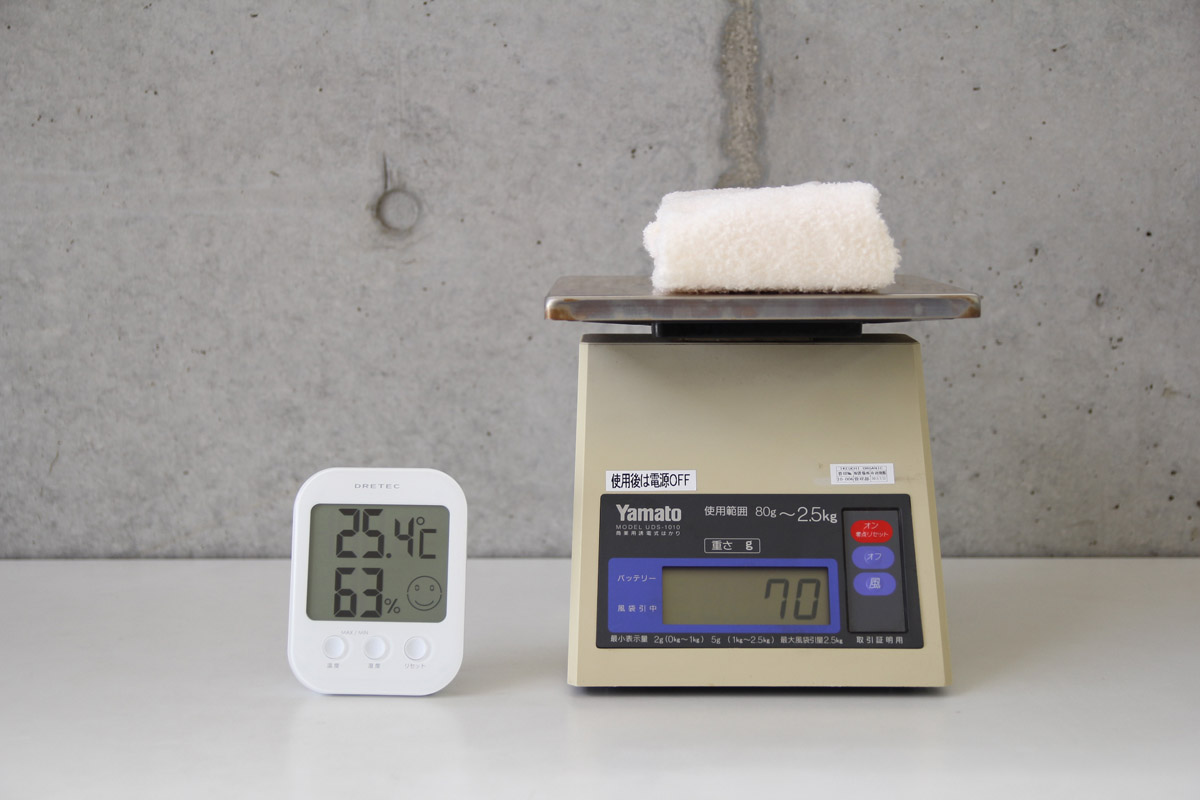
The first thing that moved after room-drying was “Organic Air. When I touched it with my hand, it was almost dry. The first weighing was done, and it weighed 70 g. Only 10 g of moisture remained. After that, measurements were taken every 10 minutes, and the moisture content steadily decreased to 66g, then 64g, and so on.
~After 150 minutes (2 hours and 30 minutes)
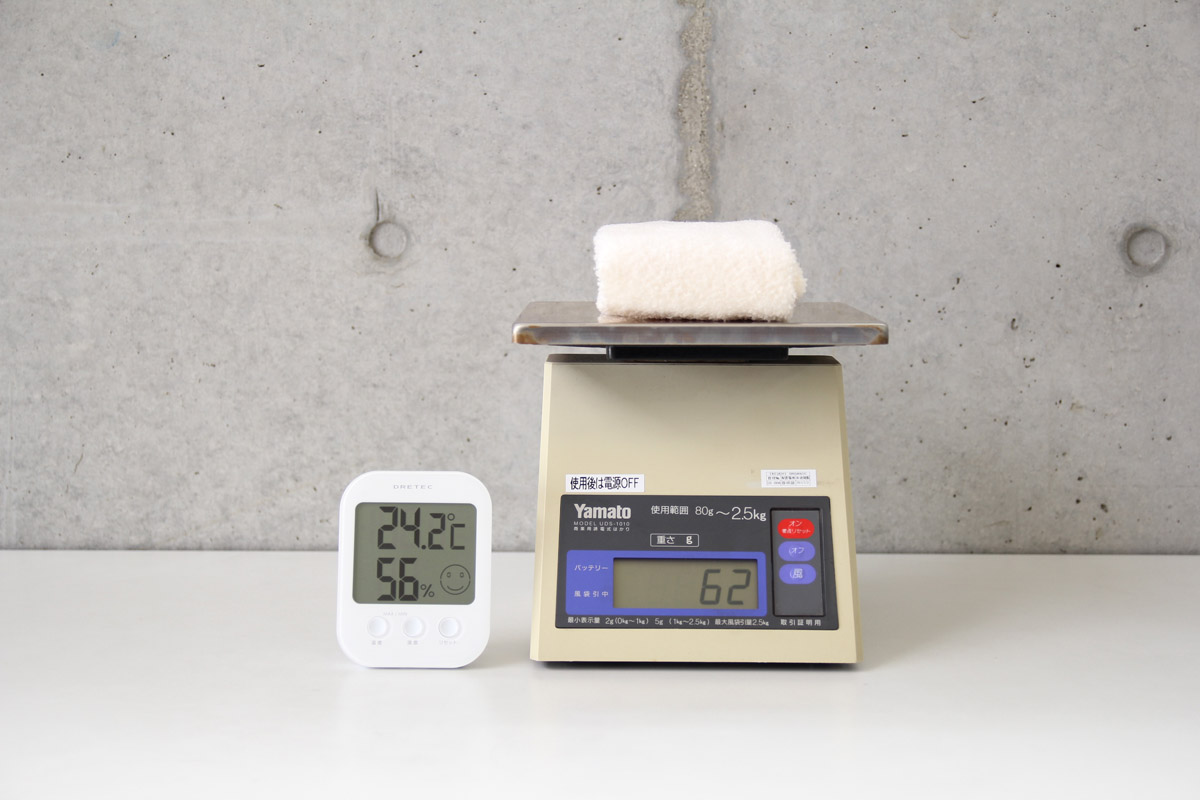
Organic Air” feels dry to the touch without a moist feeling. The measurement of attention is 62g! So, “Organic Air” came in first place.
What about other towels?
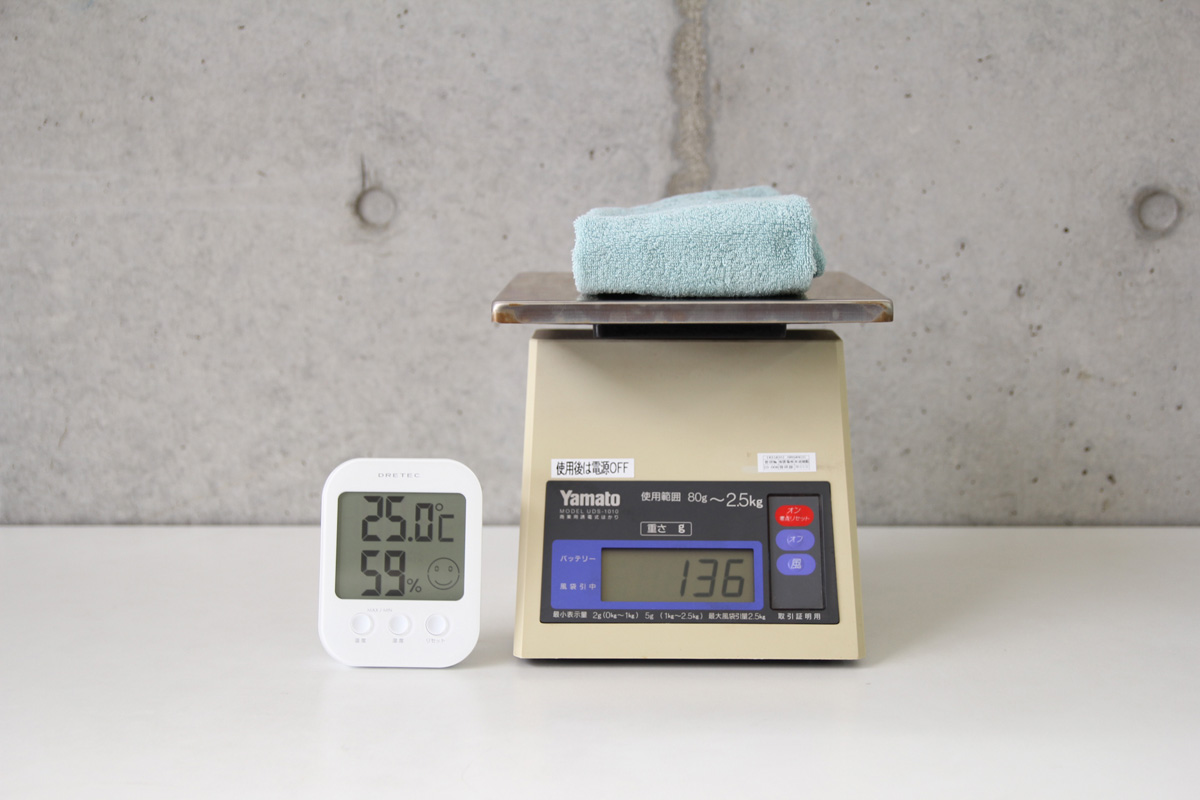
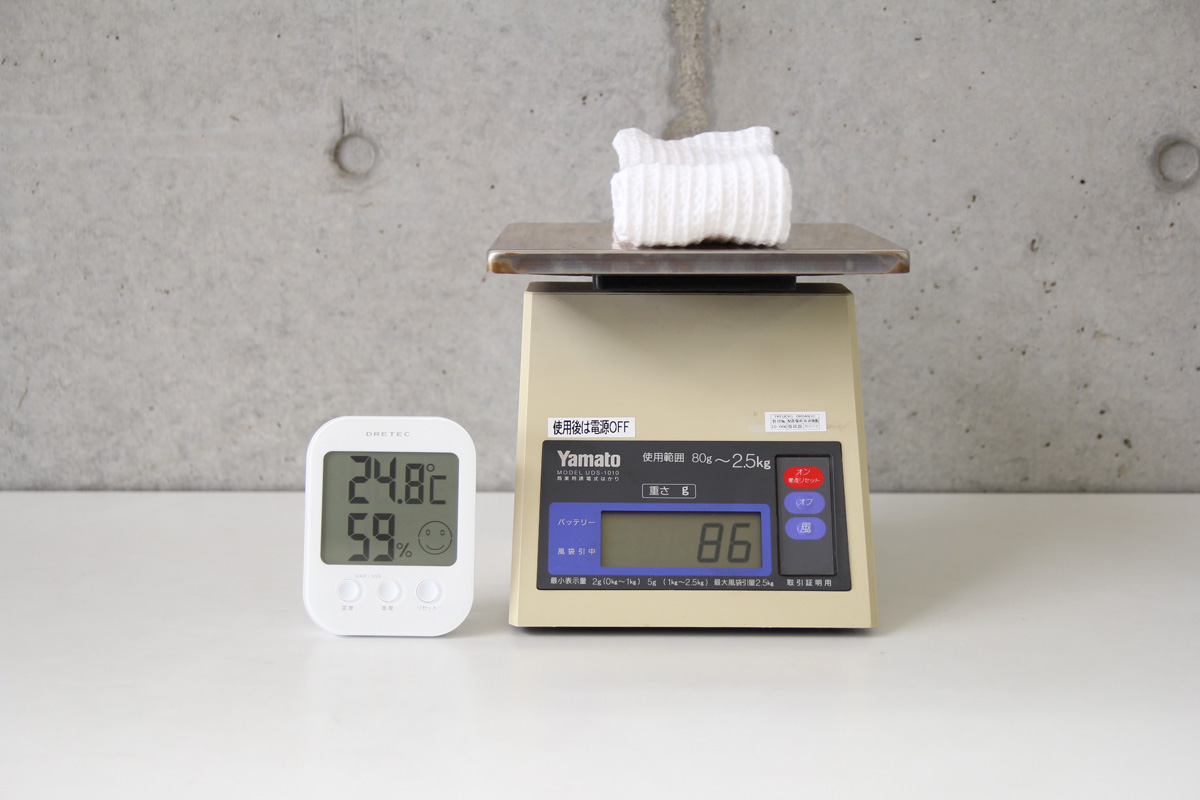
At the same time, we also measured the other towels that were drying out. Organic 120″ weighed 136g and had 30g left, and felt moist to the touch. Organic I340″ weighs 86g and has 16g remaining, which also still feels moist to the touch.
~After 230 minutes (3 hours and 50 minutes)
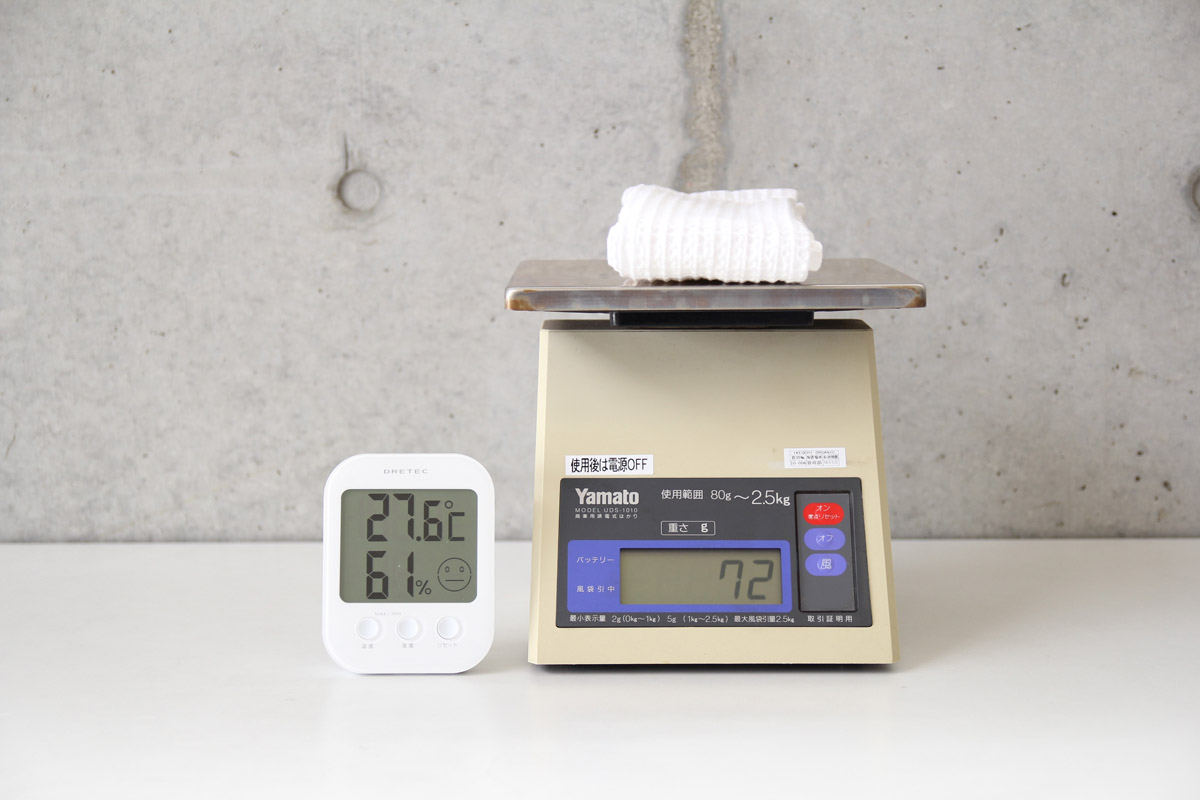
The “Organic I340” is almost dry, weighing 72 g. It feels less moist to the touch and can be judged as dry.
~After 250 minutes (4 hours and 10 minutes)
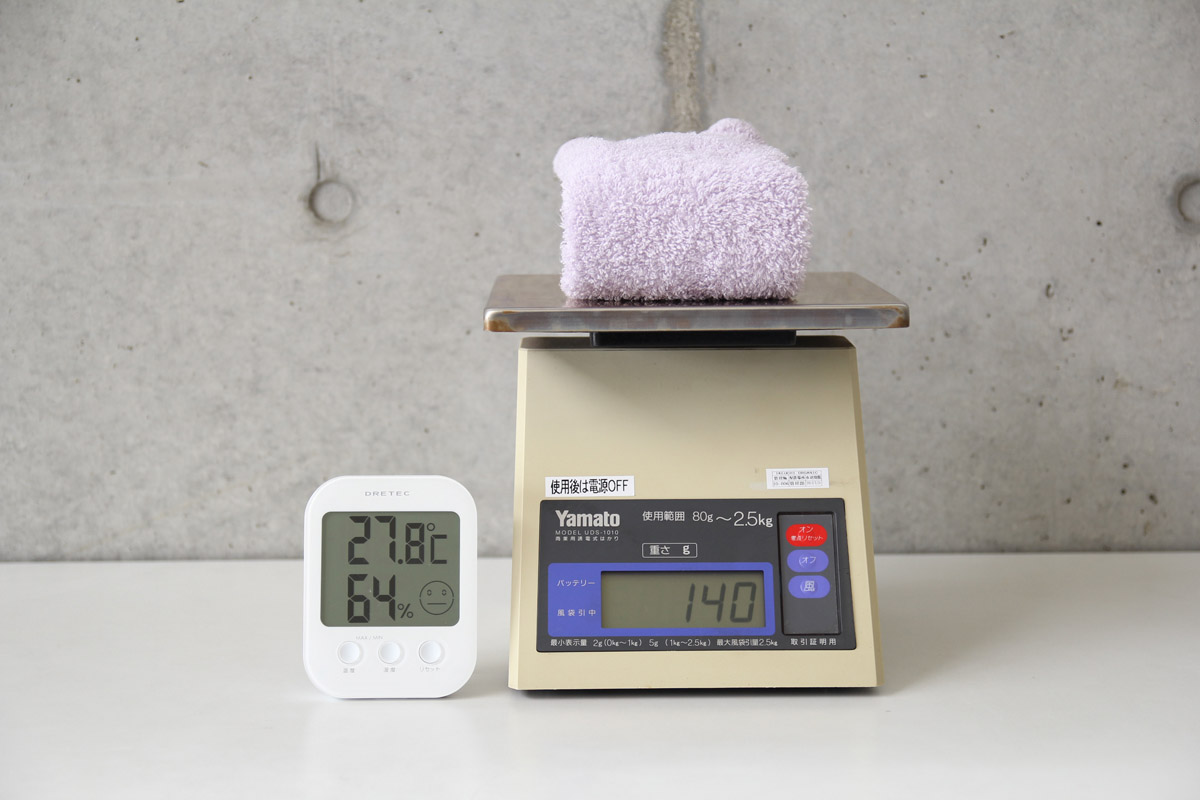
The inside of the hair of “Organic 520” is starting to feel dry. The weighing result is 140 grams, with 10 grams of moisture remaining.
~After 300 minutes (5 hours)
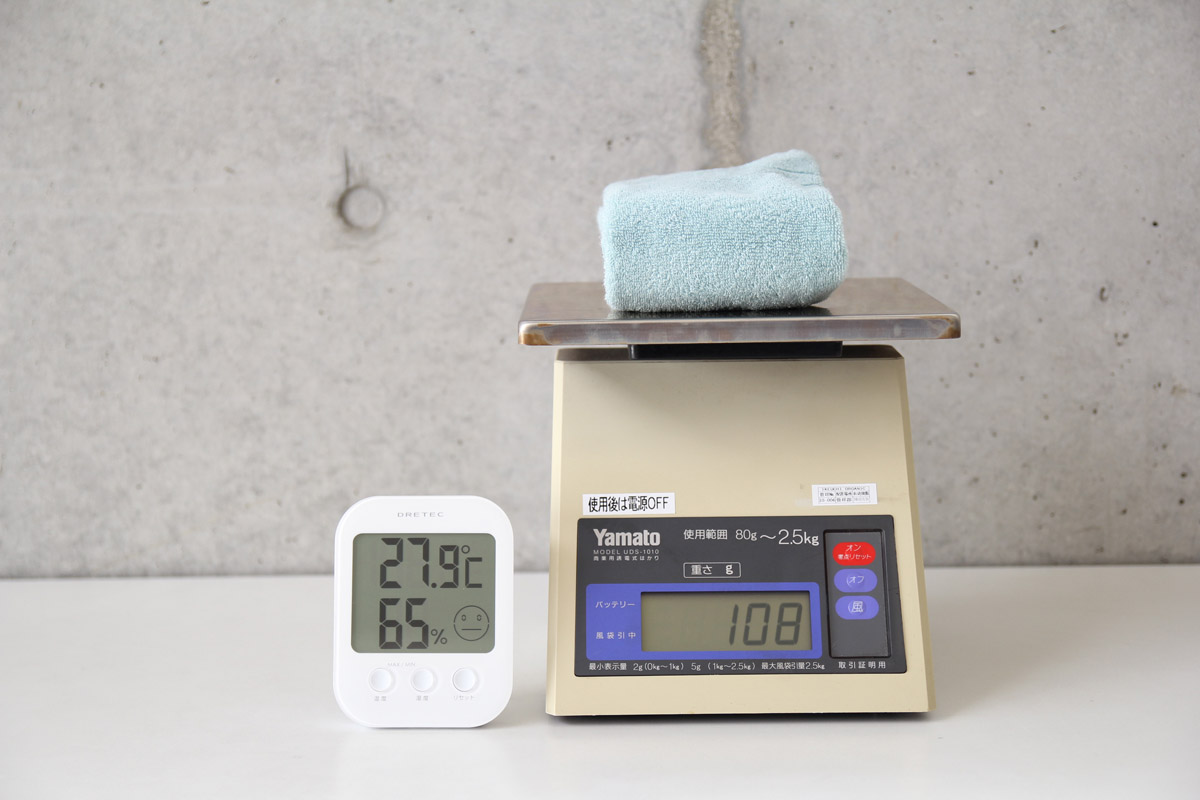
The “Organic 120” weighs 108g, and with 4g remaining, it feels almost dry to the touch. We would like to consider it dry, but we will wait and see.
~After 320 minutes (5 hours and 20 minutes)
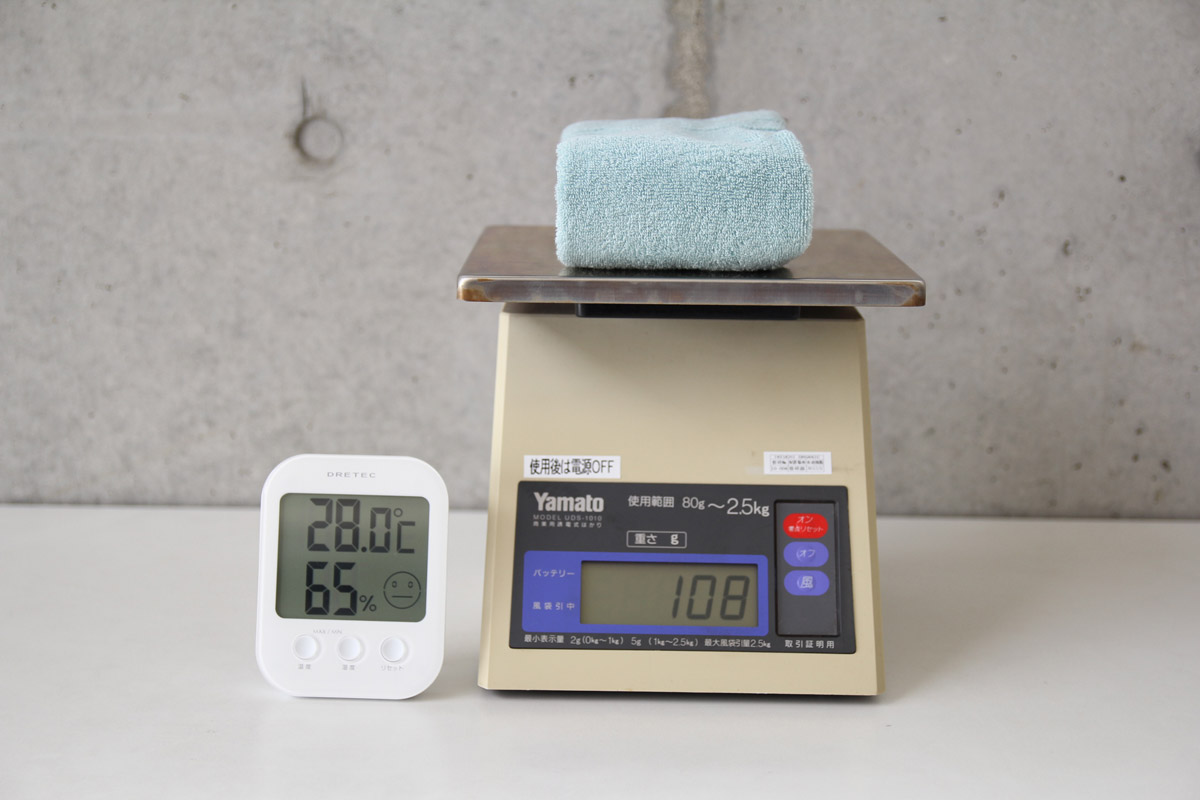
The “Organic 120” is already judged to be dry to the touch, but the measurement still shows 108g, which is 4g more than before the start, but we can call this the goal.
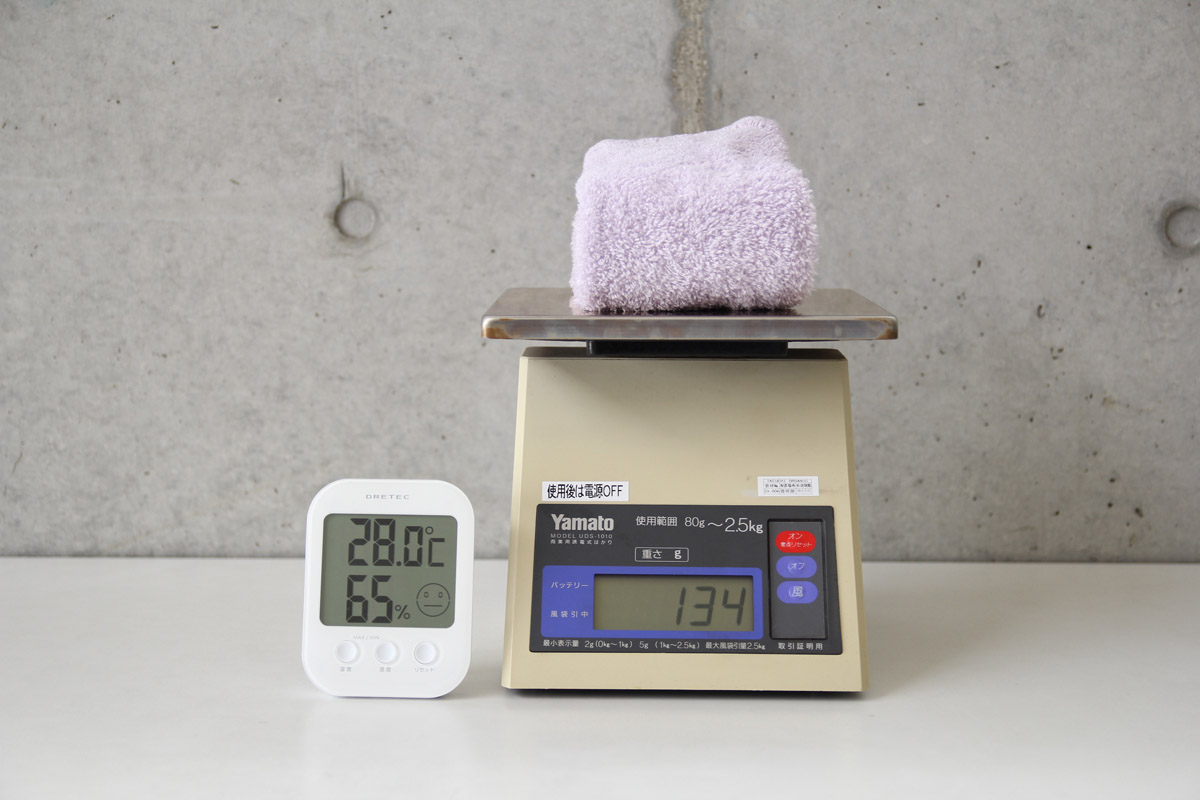
The third place went to “Organic 120”. “Organic 520” was also measured and found to have dried to 134g, a difference of plus 2g from the start. However, I felt dampness in the heme area and decided to watch it a little longer.
~After 340 minutes (5 hours and 40 minutes)
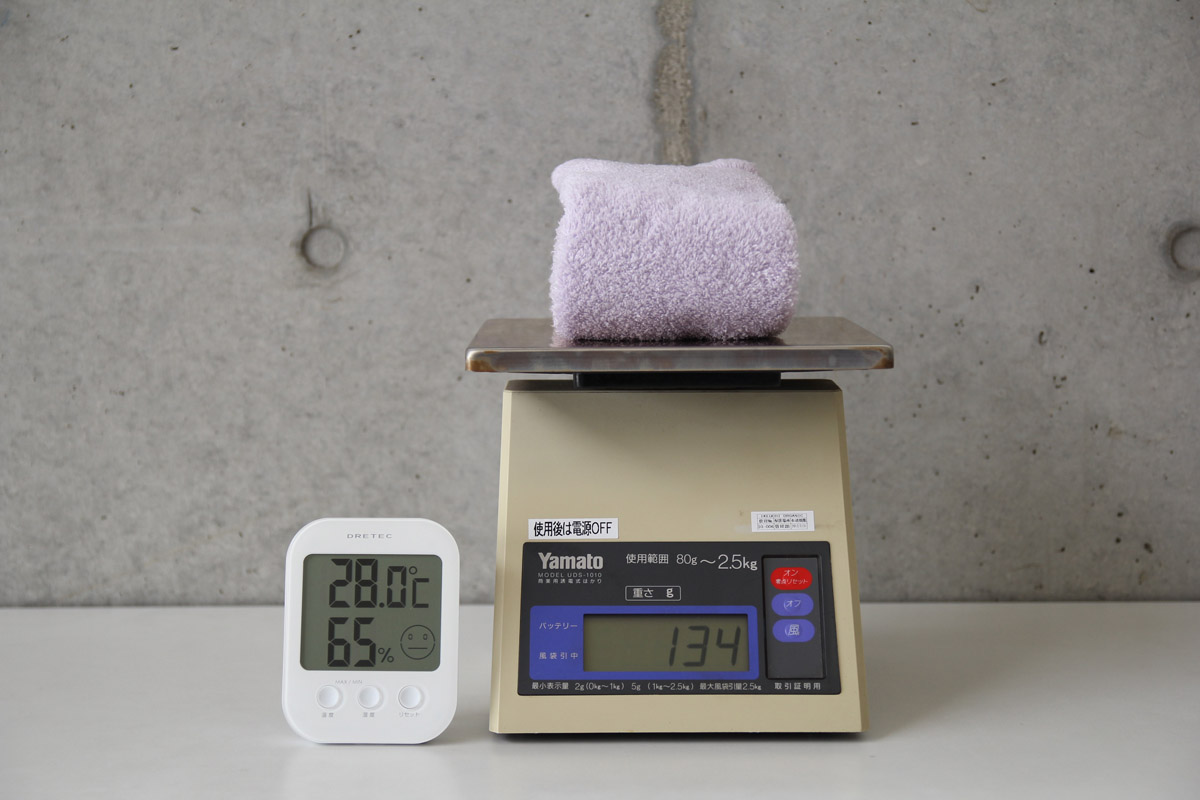
Organic 520″ remained the same at 134g, but the hems were also dry, and we judged this to be the goal, finishing in 4th place. If the amount of yarn used is large, will there be a difference between the feeling of touch and the actual weighing value? I was wondering about that.
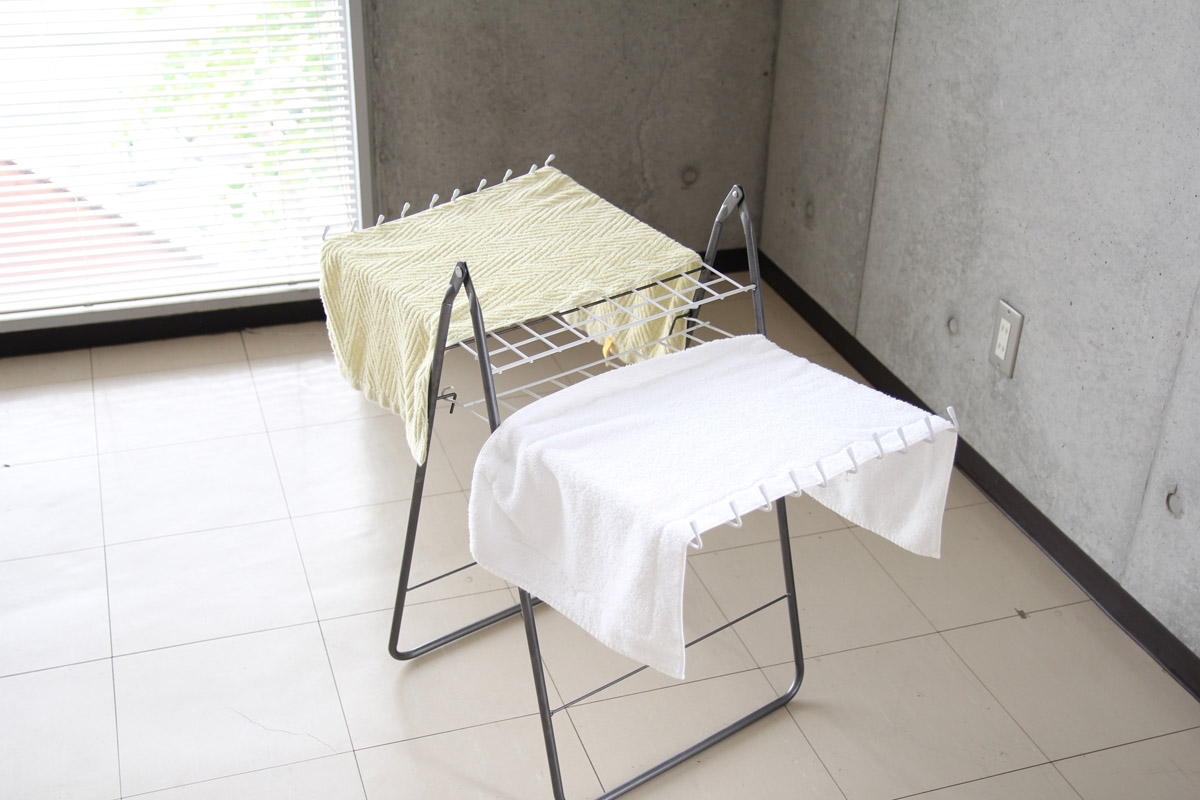
With “Organic 540” having reached the goal, the remaining two pieces are “Cotton Nouveau 2016” and “Bamboo 120”. From here, we will continue to dry them indoors in a more dryer format by spreading them out on a rack.
~400 minutes (6 hours and 40 minutes) have passed.
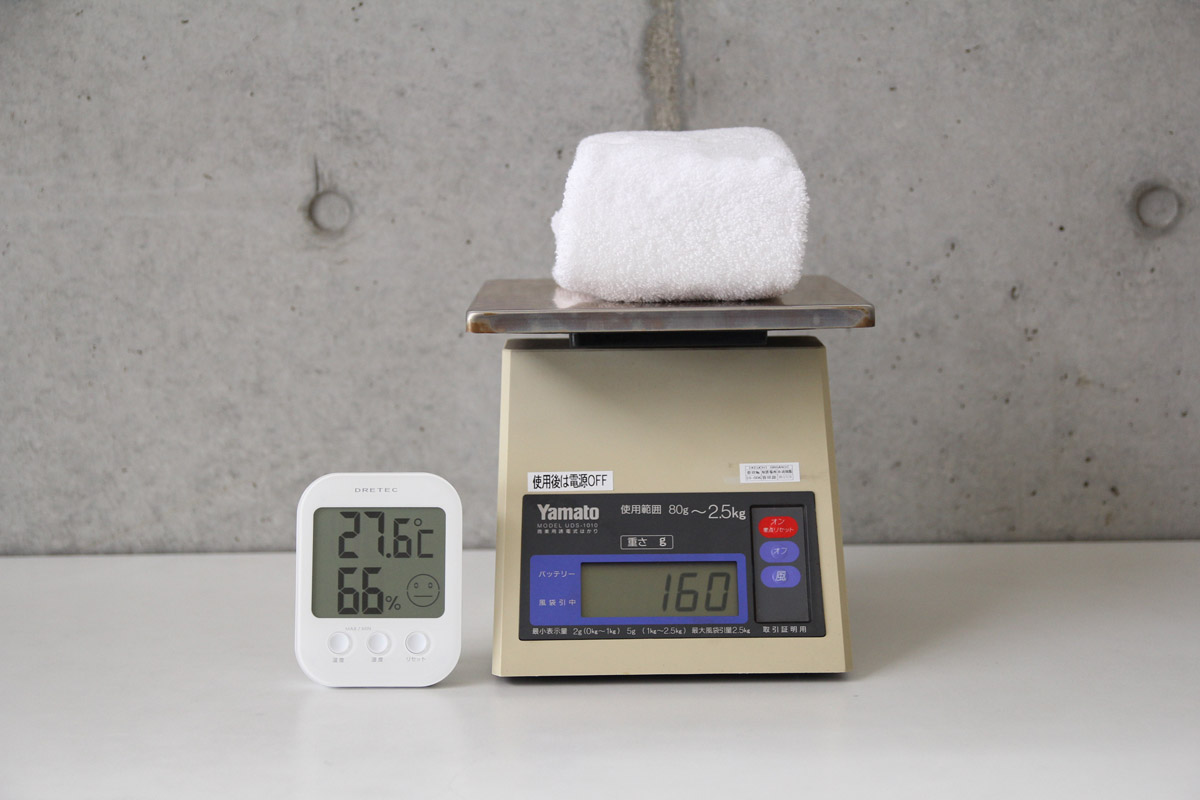
Cotton Nouveau 2016″ weighed 160 grams with 4 grams remaining, but it felt dry enough to the touch, so we reached our goal here. Bamboo 120″ had 136 grams at this point, with 10 grams of water remaining, and was still far from dry to the touch.
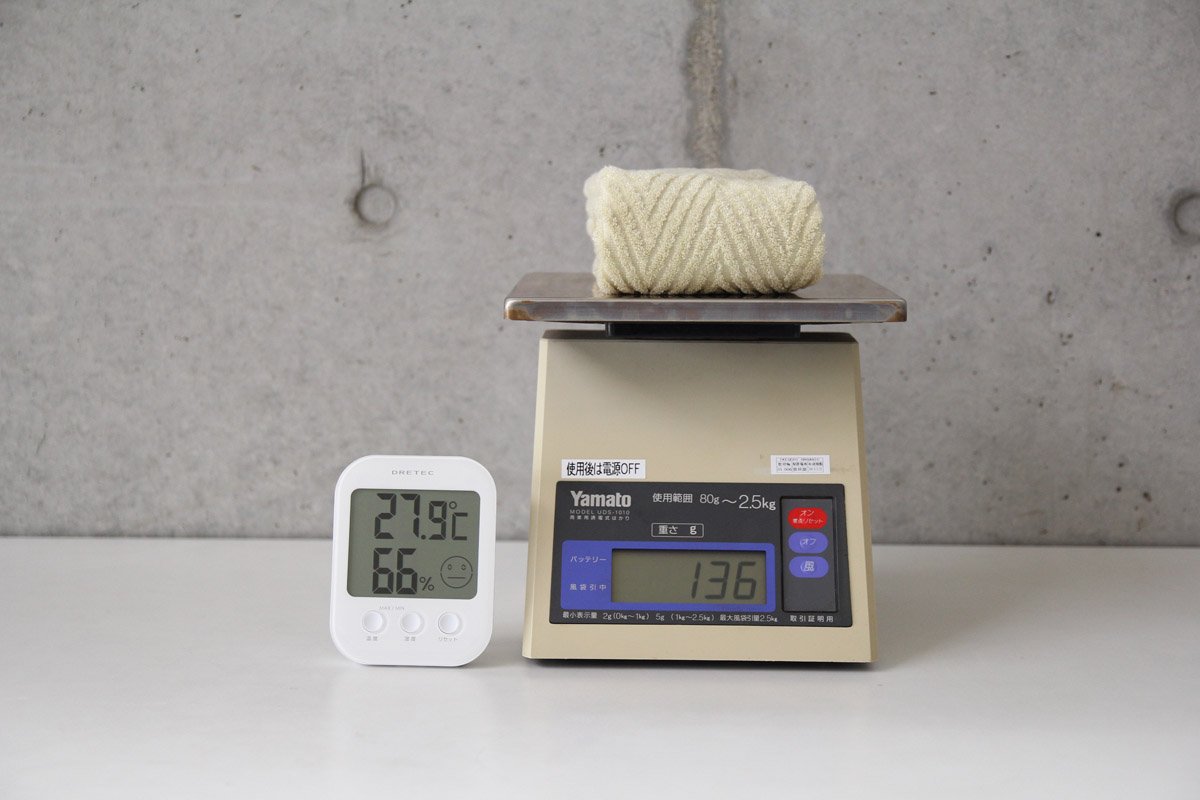
Final Ranking Results
| 1st place | Organic Air | 2 hours and 30 minutes |
| 2nd place | Organic I340 | 3 hours 50 minutes |
| 3rd place | Organic 120 | 5 hours 20 minutes |
| 4th place | Organic 520 | 5 hours 40 minutes |
| 5th place | Cotton Nouveau 2016 | 6 hours 40 min |
| 6th place | Bamboo 120 | Time expired and 7 hours elapsed 134g 8g |
The results of the experiment were as above. As expected by most, “Organic Air” came in first, followed by “Organic I340” and “Bamboo 120” at the bottom. The ranking of the towels was almost in the order of the lowest water content measured after washing, which means that towels that absorb a lot of water are difficult to dry, which was also the result of the experiment. Among them, “Organic 120” contained 6g of extra moisture than “Organic 540,” but it was very interesting that “Organic 120” dried before “Organic 520” due to the difference in hem shape and other factors.
In fact, prior to this room-drying experiment, we hung the towels outdoors in the shade at 25.5 degrees Celsius, 71% humidity, and cloudy weather, using the same drying board as used in this experiment, and all the towels dried quite quickly. The only difference was in the 4th and 5th place. The difference was probably due to the fact that “Organic 520” was pile up to the hem.
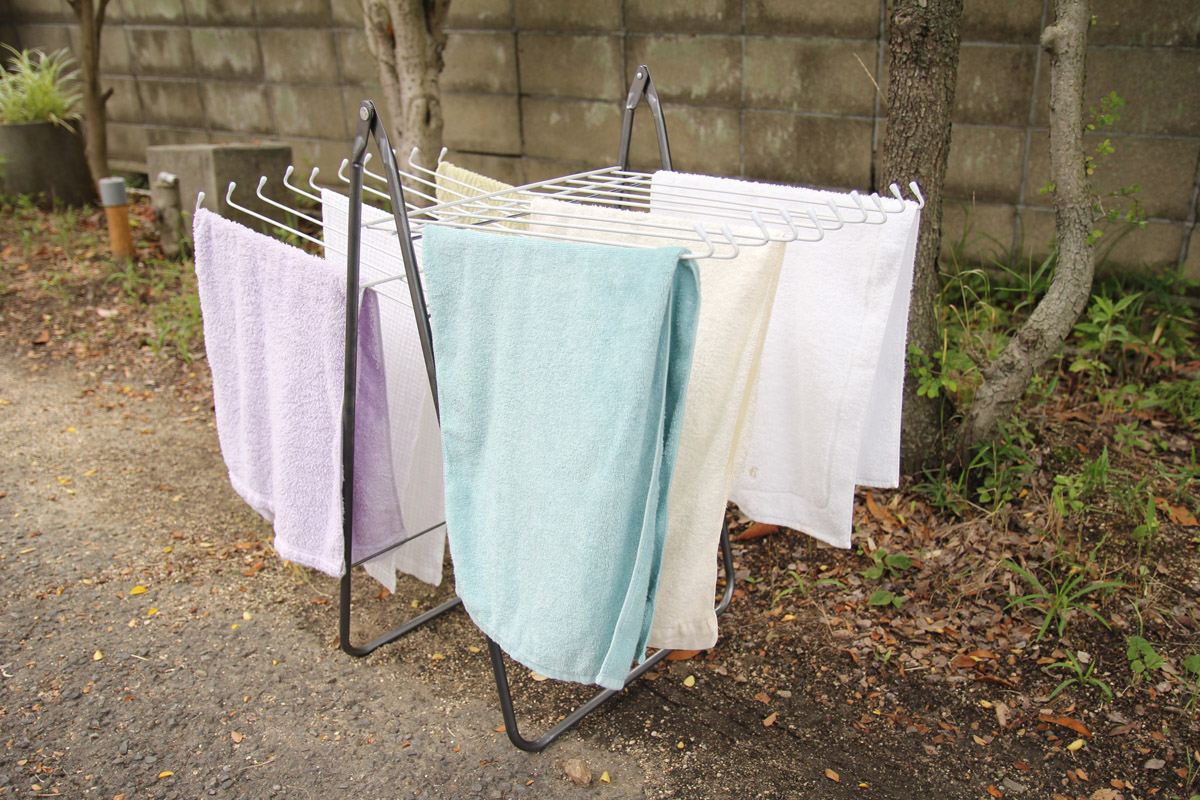
Reference record: Results of the experiment of drying in the shade outside
| 1st place | Organic Air | 1 hour and 30 minutes |
| 2nd place | Organic I340 | 2 hours 30 min. |
| 3rd place | Organic 120 | 2 hours 50 minutes |
| 4th place | Cotton Nouveau 2016 | 4 hours |
| 5th place | Organic 520 | 5 hrs. |
| 6th place | Bamboo 120 | Time out, 6 hours elapsed 128g 6g |
Organic Air is the towel that dries well even during the rainy season
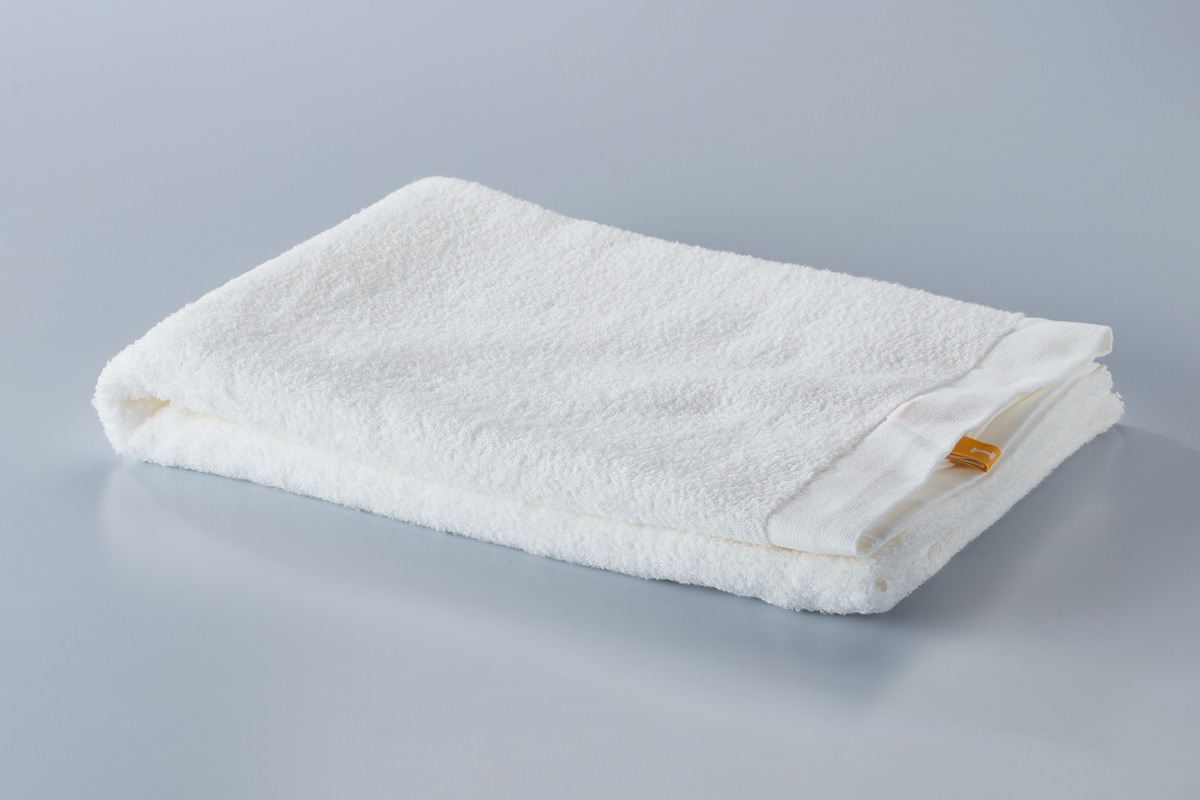
This experiment concluded that the towel that dries well even in the humid rainy season is “Organic Air. We also found that the technique to dry towels faster when drying them indoors is to use a clothes hanger and hang the towels on the bellows with a clothespin, or to use an air conditioner to lower the humidity in the room, or to use a fan to create a breeze to blow the towels while they are drying. air conditioner to lower the indoor humidity, or use a fan to create a breeze. These measures may help dry towels faster and eliminate the unpleasant smell of room-dried towels.
This experiment focused only on drying towels after washing and drying them indoors.
Experiments and article production: Kamio (webmaster)
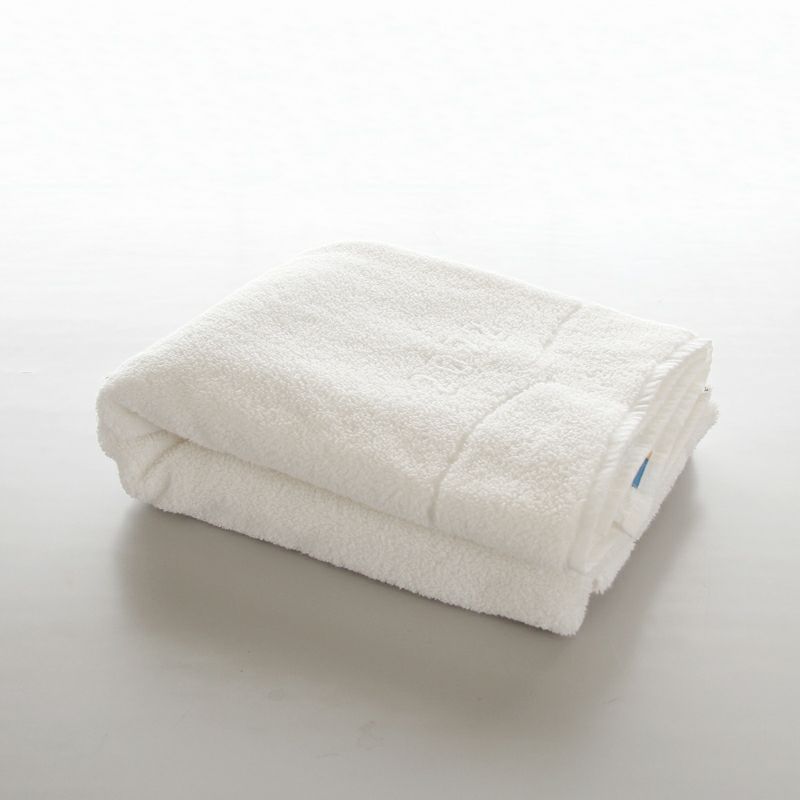
Article written by
イケウチオーガニック


